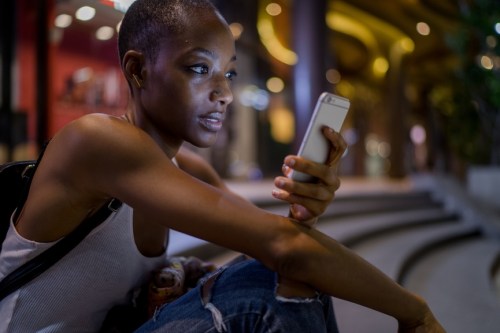How sharing images of violence against Black people damages their mental health
Experts explain how sharing violent images of Black people being killed is dehumanizing, and more damaging to Black mental health than it is anything else.

The last thing I want to do right now is look at social media. I know that within minutes, if not seconds, I’ll again be confronted with the video of a police officer kneeling on George Floyd‘s neck. As a Black woman, I’m overwhelmed at the sight of the same devastating images over and over again, knowing that any number of people I love could be next. Some argue that sharing violent images helps to propel movements. But in excess, it’s more damaging to Black mental health than it is anything else.
Police brutality against African Americans isn’t new. It dates back to the formation of the first centralized police forces created in Boston and New York in the early-to-mid 1800s, explains Robert Motley, MSW, lab manager of the Race and Opportunity Lab at Washington University in St. Louis. “These things have always been happening, it’s just that social media has created a pathway so people can be more exposed to a lot of the things that are going on,” he says. Aside from videos with a trigger warning, little protects people from being repeatedly bombarded with the same violent images. “Anybody can go on Twitter or Facebook and just see these videos. Even when you’re watching the news, the constant showing of these videos can be emotionally overwhelming and taxing for a lot of individuals,” says Motley.
Motley explains that such repeated exposure to visual racism is having an adverse impact on the physical and mental health of African Americans. “A lot of different scholars have documented an association between exposure to racism and psychological and emotional distress, hypertension, anxiety, depression, even poor academic performance,” says Motley, who recently co-authored a study on the impact of images of racial violence on young Black men. “And in some of the research, they’ve also shown us an association between preterm and low-birth rate deliveries for Black Americans as well.”
“It’s image after image after image without revolutionary change.”
Danielle Kilgo, PhD, an assistant professor of journalism who researches the relationships between media, audiences, and marginalized populations, acknowledges that revolutionary images can have tremendous impact on social movements. She points back to 2010, when images of Tunisian street vendor Mohamed Bouazizi, who set himself on fire after being harassed by municipal officials, helped to launch the Arab Spring. But today, in America, it’s not new that Black people are unjustly killed. “It’s image after image after image without revolutionary change,” says Dr. Kilgo. “There are consequences to repeatedly showing deaths and repeatedly showing the trauma.”
For Dr. Kilgo’s dissertation, she showed both Black and white individuals repeated images of race-based violence against Black people and asked them to share any thoughts or fears that came to mind.
“When you look at the responses from the Black people that I interviewed in this study, they were tragic,” says Dr. Kilgo. “Many people cried when they looked at these images and discussed their history and their family histories. These images can pull out trauma that has been buried for years or trauma that is still surfaced in their current emotional state.”
“These images can pull out trauma that has been buried for years.”
In addition to the emotional tax levied on Black people, Dr. Kilgo explains that when images of Black people being killed are repeatedly shared on social media, it’s easy for some people to forget that they’re looking at a human. When people use social media, they inherently share images and videos with shock value. But she says the same mindset shouldn’t be applied to images and videos that depict death.
From outcries against racial injustice on social media to riots in the streets, the massive response we’re seeing to George Floyd’s death would not have happened without the video, says Dr. Kilgo. The evidential value of having this video does not mean that its useful to reshare something that’s already widely available to your personal social media network.
“If you see the video of George Floyd, I think it’s important to recognize how traumatic [the video] could be for other people, especially people who identify with him,” says Dr. Kilgo. Instead of resharing a video that is already widely circulated in the media, she says to instead share supporting content. “By posting things other than just his death, [you can share] histories of how this happened, or advocacy agendas, or other kinds of grievances that relate to this,” she says. “We can drown out these videos a little bit if we can give people other things to look at.”
We must share, too, the images and stories that celebrate a man’s life. We must grieve not only the unjust actions that led to George Floyd’s death, but the life that was taken from him.
Sign Up for Our Daily Newsletter
Get all the latest in wellness, trends, food, fitness, beauty, and more delivered right to your inbox.
Got it, you've been added to our email list.








